Picto Diary - 17 April 2017 - Bago, Myanmar
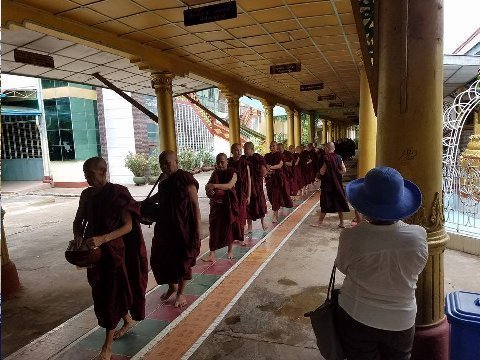
Above: TIMDT observes Buddhists monks filing to mid day meal. Kyat Khat Wyne Monestery. Bago, Myanmar. 17 April 2017
The monks eat twice a day. Once at 5:00 AM and again, just before noon. It is forbidden to eat solid foods between noon and 5:00 AM the next morning.
The food is donated. Visitors to the monastery are not required to donate food or money, but, may do so if they wish. If visitors wish to participate in the meal they are welcome. Few, if any visitors, mostly tourists like ourselves, participated in the meal with the monks.

Above: TIMDT observes distribution of rice to the monks. Kyat Khat Wyne Monastery, Bago, Myanmar. 17 April 2017.
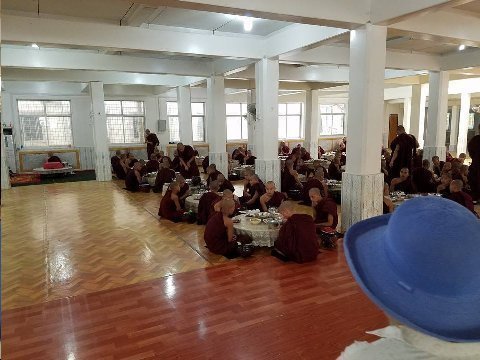
Above: Monk meal. Kyat Khat Wyne Monastery. Bago, Thailand. 17 April 2017.
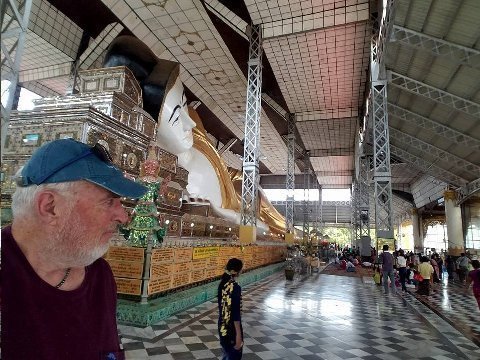
Above: The Bishop observes Shwethalyaung Buddha. Bago, Myanmar. 17 April 2017.
At 70 meters, the largest reclining Buddha in Myanmar.
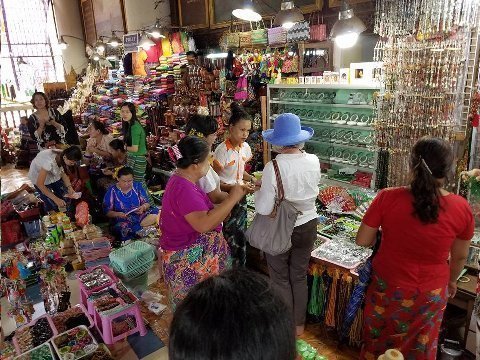
Above: TIMDT checks out the jade bracelets. Shwethalyaung Buddha. Bago, Myanmar. 17 April 2017.
Most of the world's jade is found in Myanmar.
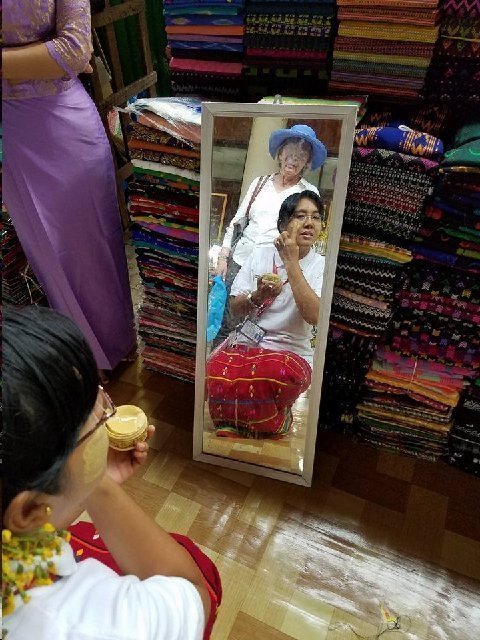
Above: Guide Khin, TIMDT behind in the mirror, applies tha na kha to her face. Shwethalyaung Buddha. Bago, Myanmar. 17 April 2017.
A local custom. A majority of the women had this very visible paste on their cheeks. Khin said it was good for the skin. It also, she said, acted as a sort of sun screen.
The paste is derived from crushed wood, milled in a pestle, and mixed with water.
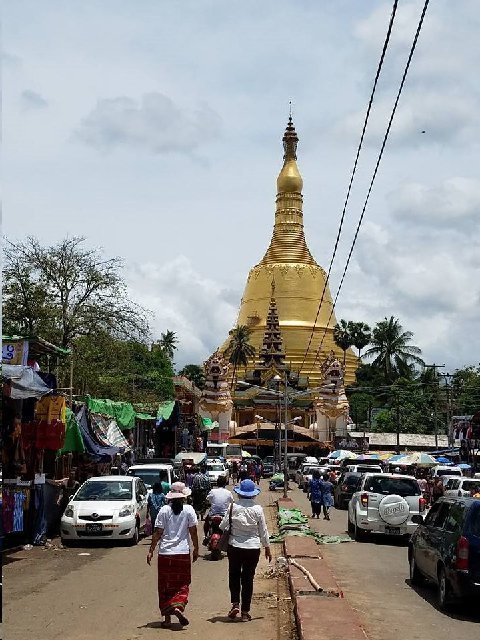
Above: Guide Khin and TIMDT walk towards Shwe Maw Daw Pagoda. Bago, Myanmar. 17 April 2017.
Today, TIMDT and Mwah (sic) left the Regent herd, hired a car (driver Nev) and a guide (Khin) and drove to Bago... two hours from the ship's port near Yangon.
Talking and listening around, we learned that there were five "must do" touristic spots in Myanmar. Bagran (the foremost), site of major ancient temple complex, Inle Lake, Mandalay, Yangon, and Bago. Bagran was reachable via Regent organized special air flight, two overnights away from the ship. However, TIMDT and Mwah elected to stay near the ship and concentrate on two of the five: Yangon and Bago.
I have almost completed reading a book I purchased in Singapore, "Survivor on the River Kwai." WWII history buffs could also visit spots along the Rangoon - Bangkok railway constructed by British and Australian prisoners of the Japanese. Such visits would require special permits and specialized tour arrangements.
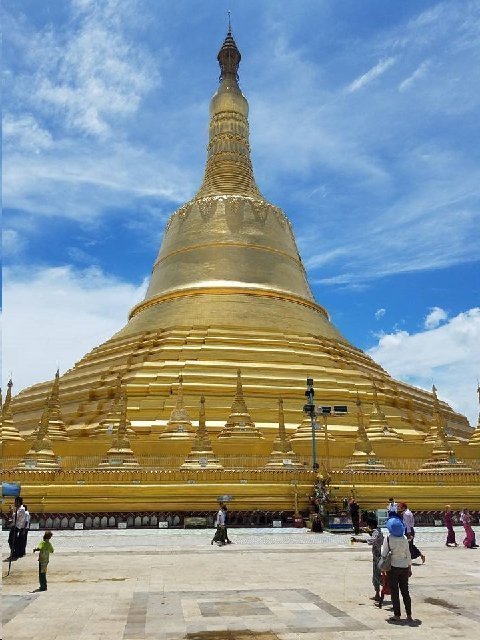
Above: TIMDT observes Shwe Maw Daw Pagoda. Bago, Myanmar. 17 April 2017.
MOAP (Mother of All Pagodas).
Tallest Pagoda in Myanmar. 357 feet. Wider at the base and taller than the Shwedegon pagoda - magnificent enough - which we saw yesterday in Yangon.
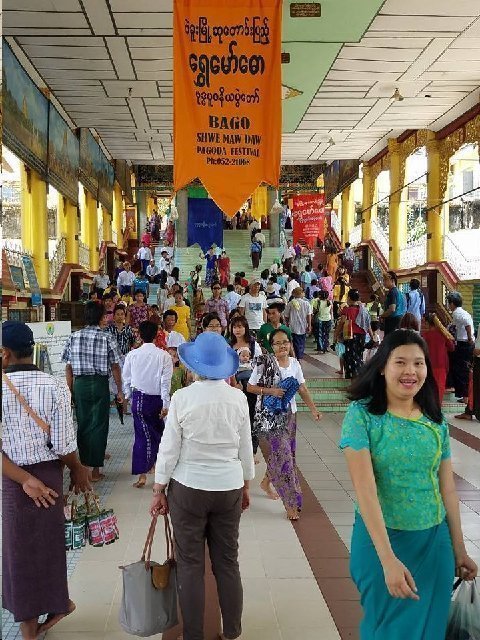
Above: TIMDT amidst the holiday crowd at Shwe Maw Daw Pagoda. Bago, Myanmar. 17 April 2017.
Today is the last day of the five day long Myanmar New Years holiday. The pagoda was packed with pilgrims and holiday goers... all in a smiling, friendly and happy mood.
Its risky to draw to many impressions or conclusions from such a short visit. But, the outward friendliness and happiness of the Myanmar people seemed to evidence almost a kind a naivete. I had the same impression when I visited Salalah, Oman ten years ago. Then, like Myanmar, Oman, had also just opened to tourism. Omanis were outwardly friendly, curious and totally unsophisticated. I expect it won't take long for openness to modern ways to harden up the Myanmar people and make them as wary and cynical as, well, say, I am.
We were fortunate to be in Myanmar during its top holiday period. In a short burst we got exposure to disproportionate number of locals than would have otherwise been the case.
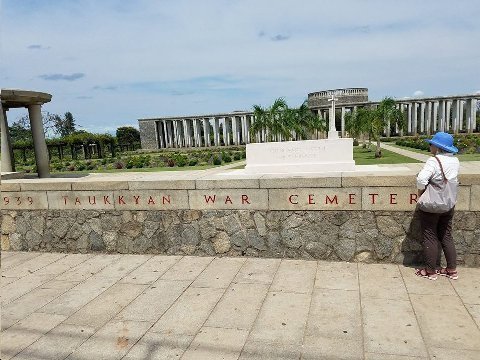
Above: TIMDT observes Taukkyan WWI cemetery. Yangon, Myanmar.
We visited this cemetery on the way back from Bago to the Seven Seas Voyager at Yangon port.
Here lie the remains of 6500 soldiers (1700 Indian soldiers) who died fighting for Great Britain against the Japanese in Burma during WWII.
The cemetery is immaculately maintained by The commonwealth Grave Commission, in the same manner as I saw, first hand, visiting Commonwealth WWI cemeteries in Flanders, France and Gallipoli two years ago.
In the end, the Burma theater was a WWII side show, having little effect on the war's outcome. Burma was a battlefield, though. The allies need Burma as a base to supply China, which couldn't be supplied from the Japanese controlled east. The Japanese needed Burma as a base from which to neutralize British India, the supply station for materiel sent to China.
Some two million Indians fought for the British in WWII. Seventy thousand Indian soldiers died in that conflict. An obsessed Indian nationalist, Subhas Chandra Bose, in a misbegotten effort to advance Indian independence from the British, cooperated with the Germans and the Japanese to create a rump army of Indian soldiers, mostly those released prisoners from Singapore Japanese prison camps, to fight against the allies. Bose's effort failed and weakened his claim on being a legitimate player in the ultimate struggle for Indian independence, later secured in 1948.
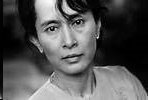
Above: Aung San Suu Kyi. File image.
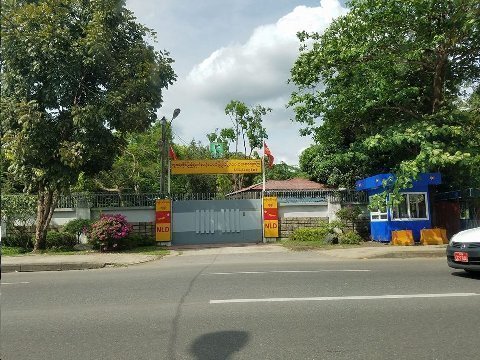
Above: Residence of Aung San Suu Kyi. Yangon, Myanmar. 17 April 2017.
Image taken by Mwah (sic) from car window as we returned from Bago to Yangon.
Yangonr is replete with beautiful parks, greenery and lakes. The central city is dominated by decaying colonial era buildings with few of the sky scrapers that have been introduced in other formerly colonial cities... Jakarta, Manila, Singapore, and KL. Military government in Myanmar, since WWII, has taken its toll... at least in terms of limited, weak economic growth.
In talking about Aung San Suu Kyi, our guide, Khin, would refer to her as "The Lady."
Wikipedia:
The youngest daughter of Aung San, Father of the Nation of modern-day Myanmar, and Khin Kyi, Aung San Suu Kyi was born in Rangoon,British Burma. After graduating from the University of Delhi in 1964 and the University of Oxford in 1968, she worked at the United Nations for three years. She married Michael Aris in 1972, and gave birth to two children. Aung San Suu Kyi rose to prominence in the1988 Uprisings, and became the General Secretary of the newly formed National League for Democracy (NLD). In the 1990 elections, NLD won 81% of the seats in Parliament, but the results were nullified, as the military refused to hand over power, resulting in an international outcry. She had, however, already been detained under house arrest before the elections. She remained under house arrest [at the house pictured here] for almost 15 of the 21 years from 1989 to 2010, becoming one of the world's most prominent political prisoners.
Her party boycotted the 2010 elections, resulting in a decisive victory for the military-backed Union Solidarity and Development Party. Aung San Suu Kyi became a Pyithu Hluttaw MP while her party won 43 of the 45 vacant seats in the 2012 by-elections. In the 2015 elections, her party won a landslide victory, taking 86% of the seats in the Assembly of the Union – well more than the 67 percent supermajority needed to ensure that its preferred candidates were elected President and Second Vice President in the Presidential Electoral College. Although she was prohibited from becoming the President due to a clause in the constitution – her late husband and children are foreign citizens – she assumed the newly created role of State Counsellor, a role akin to a Prime Minister or ahead of government.

Above: View, looking down the Yangon River, from 11th deck observation lounge. Seven Seas Voyager. 17 April 2017.
There is not much more to this port than what is seen in this image.
There is room for another four ships along the pier where we are docked. There is only one crane track with one crane.
It speaks to Myanmar's impoverishment, relative, say, to similarly sized countries in the region, such as PI, Malaysia, and Thailand... not to mention tiny Singapore, all of which have massive port facilities and burgeoning economies.
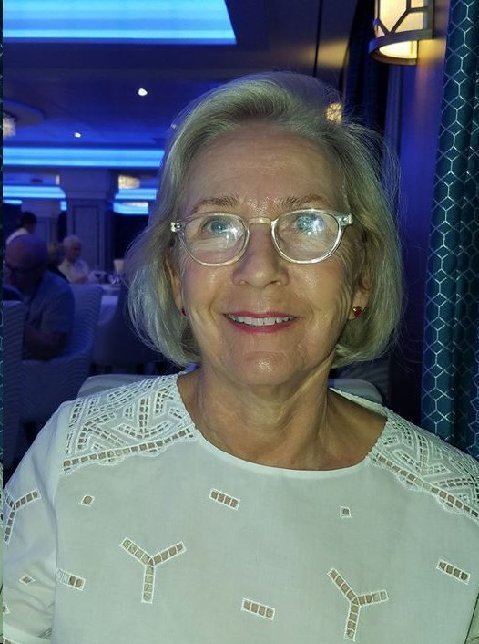
Above: TIMDT. 11th deck observation lounge. Seven Seas Voyager, ship now underway into the Bay of Bengal. 17 April 2017.
Addendum:
Thanks Steve!!
I know little about Budddism and but will now find out more. After worrying so much about Islam, I need a break!
Manhattan,
Park City, UT
Great pixs, I was there in the mid 80's. Probably hasn't changed that much.
Bridge,
Palm Beach, FL
Nice reference to St Mary's Church in Axum. Marcia and I got close but never breached the walls when we lived and taught school at the Abraha Atsbaha School as Peace Corps volunteers 1965-67. One of our students became the strategic brains behind the overthrow of the Mengistu government and still today is a senior member of the Tigrean orchestrated Ethiopian government.
Privateer,
Hancock, ME
Yes Steven, we too were quite amazed by Shwedagong.
Saker
Mumbai, Maharashtra